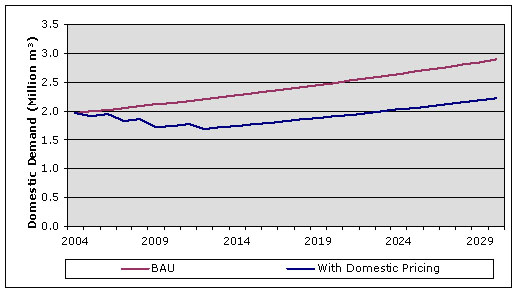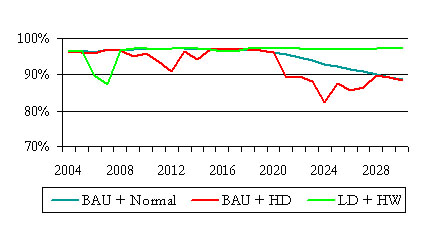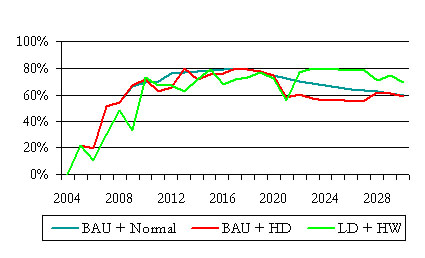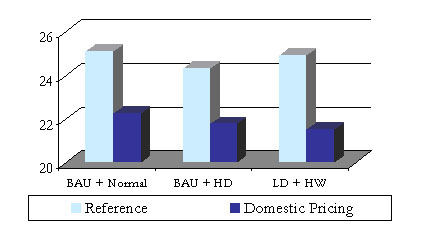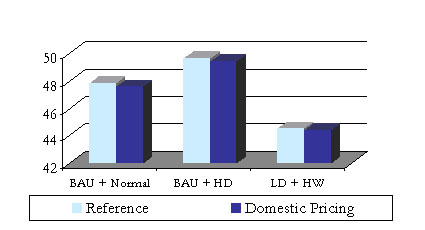
ISSUE 6 |
||||||||||||||||||||||||||||||||||||||||||||||||||||
|
|
|||||||||||||||||||||||||||||||||||||||||||||||||||
Option results |
||||||||||||||||||||||||||||||||||||||||||||||||||||
|
Figure 1 presents the new domestic demand under the examined pricing scheme for the BAU scenario. Figure 1. Domestic demand before and after pricing application (BAU demand scenario) |
||||||||||||||||||||||||||||||||||||||||||||||||||||
|
|
||||||||||||||||||||||||||||||||||||||||||||||||||||
Effectiveness |
||||||||||||||||||||||||||||||||||||||||||||||||||||
|
The significant domestic demand decrease, due to the rather large augmentation of prices and the high assumed elasticities, directly affects domestic demand coverage effectiveness (Figure 2). Especially under the LD+HW scenario, domestic pricing after 2007 stabilises effectiveness to 97%. Similarly, domestic deficits present a significant improvement, reaching almost 80% under the BAU+Normal and LD+HW scenario (Figure 3). Similar trends are observed for irrigation water use. For example, under the BAU+Normal scenario, effectiveness to irrigation demand coverage gradually increases up to the year 2015, when almost 80% of irrigation needs are covered, following the application of the pricing scheme. Figure 2. Percent demand coverage effectiveness of Domestic Use Pricing to Domestic use Figure 3. Percent Improvement of deficit in Domestic use with respect to the reference scenarios After this point, the gradual increase of domestic demand, due to population growth results to the gradual decrease of irrigation effectiveness (Figure 4). The same observation stands for the relative improvement of irrigation deficits. However, the effect under the BAU+HD scenario is much more pronounced, in some cases exceeding even 50% with respect to the reference case (Figure 5). Figure 4. Percent demand coverage effectiveness of Domestic Use Pricing to Irrigation use
Figure 5. Percent Improvement of deficit in Irrigation use |
||||||||||||||||||||||||||||||||||||||||||||||||||||
Direct and Environmental Costs |
||||||||||||||||||||||||||||||||||||||||||||||||||||
|
In all cases the option results in a significant decrease of direct costs (Figure 6). This is due to the fact that operational costs are only associated with domestic use. Consequently, the reduction of supply delivered to domestic use incurs a direct cost decrease, which under the LD+HW scenario can reach even the 13% of the present value of the respective reference case.
Figure 6. Total direct cost difference of the Domestic Use Pricing option Total environmental costs present a marginal decrease, since in some aquifers unsustainable groundwater abstractions are reduced. However, the total volume of groundwater abstractions more or less remains constant, and therefore, the decrease of the total environmental cost is very low (Figure 7).
Figure 7. Total environmental cost difference of the Domestic Use Pricing option |
||||||||||||||||||||||||||||||||||||||||||||||||||||
